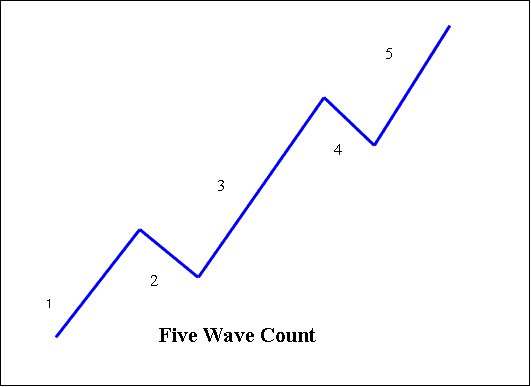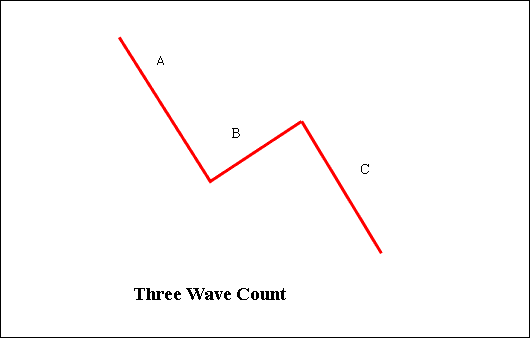The Elliott Wave Theory
This analysis type helps predict market trends. Traders spot crowd mood extremes, price peaks and dips, and group actions. The model claims human behavior follows set patterns. These show up in buy-sell choices and prices.
Ralph Nelson Elliott created this analysis method. It draws from nature's five-wave patterns. Traders apply it to study price trends in technical analysis.
When using this idea for indexes, it's thought that the market will go up in a pattern of five waves, with three moves up (numbered 1, 3, and 5) separated by two moves down (numbered 2 and 4). The three upward moves (1, 3, 5) combined with the two downward moves (2, 4) together create the 5 Wave pattern.
The underlying theory further posits that every wave structure consisting of five upward movements will subsequently be counterbalanced by a downward structure comprising three waves - this time, the three downward components are denoted by letters (A, B, & C) rather than numbers to distinguish them from the five waves defining the ascent.
5 & 3 Wave Pattern
The main trend consists of five moves, while the price retracement consists of three moves.
Five pattern formation (dominant trend) - uses 1, 2, 3, 4, 5
3 setup (corrective trend) - uses A, B, and C points

This material aims to instruct the trader on executing trades in the online markets by employing Elliott Wave Theory as the fundamental driver for instrument movements. This analytical structure places substantial reliance upon visual inspection of price charts. Technical analysts leverage this theory to examine unfolding patterns to pinpoint the existence of waves and predict prospective price actions.
By studying these patterns on a chart and using the Elliott Wave Theory, stock traders can decide when to buy and sell by finding the points where the trading market is likely to change direction.
One of the easiest places to see this theory at work is in the trading market, where the changing investor psychology is recorded in the layout of price moves. If a stock index trader can identify the repeating patterns in prices, & figure out where these repeating setup is relative to the Elliot pattern counts then the online trader can predict where the prices are likely to head to.
Rules for Elliott Wave Count
This theory forms market patterns. It has rules for what makes a count valid.
- Wave 2 shouldn't go below the beginning of Part 1.
- Wave three should be the largest among Part 1, 3 & 5.
- Wave 4 shouldn't over-lap with Part 1.
Five setup (dominant trend)

1: This is rarely obvious when it first starts. When a new bull market's first wave begins, the economic news is almost always bad. The previous market trend is still seen as very strong. Data analysts keep making estimates that are lower: a new trend probably does not look strong at first. People still feel negative, and the trading market's implied volatility is high. As prices go up, trading might increase a little, but not enough for technical analysts to notice.
2: This specific wave corrects wave 1 but is fundamentally incapable of surpassing the starting point of wave 1. Generally, negative news sentiment persists. As prices revisit the previous low, bearish sentiment rapidly intensifies, reaffirming the crowd's belief that the bear market remains dominant. Nevertheless, subtle positive indications emerge for observant participants: the trading volume during wave 2 should be lower than the volume seen during wave 1, and prices typically do not reverse more than 61.80% of the gains made during the first part of wave 1. The price action will result in a new low that is situated higher than the preceding low, thus establishing a higher low.
3: This is usually and generally the biggest and most powerful move upward, larger than 1 & 5. News is now positive and fundamental analysts begin to raise estimates. Prices rise quickly, corrections are short-lived & shallow. Anyone looking to get in on a pull-back will likely miss the boat. As three starts, the news is probably still somewhat bearish, & most/many traders remain still negative: but by part three midpoint, the crowd will often join in and agree that the new sentiment in the market is bullish. Wave 3 will extends beyond the highest point reached by 1.
4: This phase is characteristically corrective. Price movement may stall and move sideways for an extended duration, and Wave 4 generally reverses less than 38.20% of Wave 3. Trading volume during this period is significantly lower than that observed in Wave 3. It presents a favorable opportunity to enter a trade on a pullback, assuming one recognizes the potential inherent in the forthcoming Wave 5. Nevertheless, Wave 4 can often prove frustrating due to its apparent lack of forward movement within the broader uptrend structure.
5: This represents the final surge in the direction of the dominant market momentum. The associated news at this stage is nearly universally optimistic, leading to widespread bullish sentiment. Unfortunately, this is the point where the majority of retail investors finally enter the market, immediately before the price peaks. Trading volume in wave 5 is often less intense than in wave 3, and many momentum-based trading indicators begin to exhibit divergences (where prices reach a new peak, but the corresponding trading indicators do not). At the conclusion of a substantial uptrend, those attempting to short the market top may well find themselves ridiculed.
3 Pattern (Corrective Trend)

A: Corrective phases are frequently more challenging to identify compared to impulsive market movements. During phase A of a downturn, fundamental economic news is often still being reported favorably. Many analysts interpret the decline as merely a market pullback within an otherwise active upward market. Characteristic indicators associated with phase A can include elevated trading volume, increasing implied volatility, and potentially greater open interest in short-selling activity.
B: Prices reverse & move slightly higher, which many see as a resumption of the now long gone bullish trend. Those familiar with classical analysis may & might see the peak as a right shoulder of a head & shoulders reversal trade pattern. The volume during B should be lesser than in A. By this point, fundamentals are probably no longer improving, but they most probably haven't yet turned negative.
In wave C, prices drop fast. Volume rises, and by the third part of C, most see the bear trend is strong. Wave C often matches wave A in size or reaches 1.618 times beyond A's low.
More Tutorials and Topics:
- Methods for Trading the EUROSTOXX Index Online
- Nikkei 225 Stock Market Stock Index Strategy
- UKX 100 Strategy How to Create Stock Index Strategy for UKX100 Lesson
- How Can I Add SPX 500 in MT5 iPhone App?
- Best SX 50 Trading Indicators Described
- Locating Indices within the Navigator Panel on MetaTrader 4
- S&P MT4 S&P Software Platform
- Discover the best stock index strategy for the UsTec100.
- How to Trade the SX 50 Chart
- Guide of Stock Index Market

